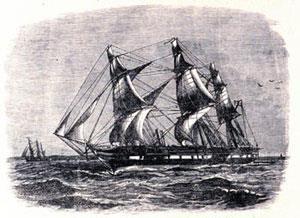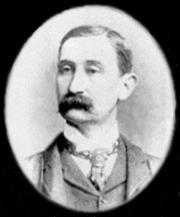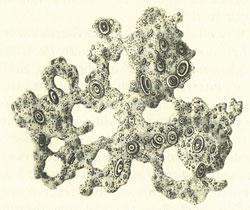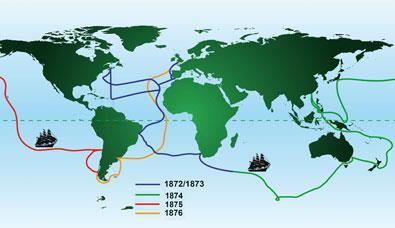A long voyage led one young chemist to steer evolutionary biology onto the right course. Richard Corfield explores the life of chemistry's Darwin
A long voyage led one young chemist to steer evolutionary biology onto the right course. Richard Corfield explores the life of chemistry’s Darwin
135 years ago, a small steam and sail corvette slipped her moorings from the quayside in the bustling UK naval city of Portsmouth and set out on one of history’s most extraordinary voyages of scientific discovery. HMS Challenger had been tasked - via an unlikely collaboration of the British Navy and the Royal Society - to perform the first detailed study of the world’s oceans.

The voyage had four specific objectives. The first was to investigate the physical conditions of the deep sea in the great ocean basins - as far as the neighbourhood of the Great Southern Ice Barrier - with regard to depth, temperature, circulation, specific gravity, and penetration of light. Secondly, it sought to determine the chemical composition of seawater at various depths - the organic matter in solution, and the particles in suspension. Thirdly, it would attempt to ascertain the physical and chemical character of deep-sea deposits and the sources of these deposits. And finally, it would investigate the distribution of life at different depths and on the deep seafloor.
Along with the usual complement of naval ratings and officers, the Challenger carried a scientific crew of five to undertake these Herculean tasks: Charles Wyville-Thomson, emeritus professor of zoology at the University of Edinburgh, UK; John Murray, a fiery tempered and outspoken Canadian who was to become the most famous of all Challenger scientists as the lead author of the massive 50-volume tome that eventually ’summarised’ their findings; Henry Moseley, a young natural historian from the University of Oxford, UK; Rudolf von Willemoes-Suhm, a German naturalist who joined the expedition at the last minute; John Wild, Wyville Thomson’s secretary and the expedition artist; and the most enigmatic, but one of the most crucial of the group, a Scottish chemist named John Young Buchanan.

At twenty-nine years of age, Buchanan had come to science relatively late, having started a degree in Glasgow to read arts before discovering a deep-seated love of chemistry. After studying on the Continent he returned to Scotland to work with Crum Brown, the noted professor of chemistry at the University of Edinburgh. Buchanan was a superbly practical chemist, capable of making his own instruments and skilled in the art of glass blowing - something that was likely to be in great demand on a naval vessel braving some of the roughest waters in the world.
He was a kind and very sincere man, but so painfully shy that his warm nature often remained hidden. When he did form friendships they were deep and long-lasting. This was the case when he met the young German, von Suhm, who was feeling very alone and overwhelmed when he joined Challenger at the end of November 1872.
Like Moseley, Buchanan was eager to establish a well-equipped, on-board laboratory. Consequently, one of the gun bays on the main deck was converted into a tiny physical and chemical laboratory for his use. This marvel of miniaturisation managed to contain the paraphernalia of a traditional Victorian chemistry laboratory - retorts, stills, test tubes, hydrometers, thermometers, blow-pipes - all held neatly in place by ingenious devices to counteract the motion of the ship.
The purpose of the chemistry lab was to analyse the seawater and sediment samples that would be brought up during the course of the expedition. A sounding line, made of a rope of woven piano wire, would be used to collect the samples. Attached to this, at intervals, were thermometers for measuring the thermal structure of the ocean, and remote-controlled flasks for taking samples at different depths. At the end of the sounding line was a device for retrieving sediment samples from the seafloor itself.
It was essential to use steam power while dredging and sounding, because only with a consistent push from the propeller could the attitude and position of the ship be kept constant. Under sail she would drift miles off-station, but with the steam engine churning and her bow head-on into the sea, enough way could be put on to achieve a stable position from which the sounding line could be run out.
The crucible of time
Buchanan’s greatest contribution to the voyage, and to the history of biology as a whole, was his debunking of a theory that could have done as much damage to the science as Lysenkoism - Trofim Lysenko’s doctrine that characteristics acquired during life could be inherited - had done to Soviet biology during Stalin’s reign as Soviet leader in the mid
20th century.
But the cast of characters behind Buchanan’s story were a great deal more wholesome than Lysenko. They were all passionately concerned to advance the theory that had then only recently rocked the Victorian world to its foundations - Charles Darwin’s theory of evolution by means of natural selection.
By the middle years of the 1860s the foundations of the theory were in place and central to all of them was the notion of progress from simple forms to those of increasingly greater complexity. So mammals were more advanced than reptiles, which were in turn more advanced than amphibians, which were more advanced than fish and so on. This reasoning covered not only the vertebrates, but all of the invertebrates and single celled protozoa. Between all of these ’grades’ of animal organisation it was thought there must be transitional forms with intermediate characteristics - so-called ’missing links’.
The champions of the theory were Darwin’s tenacious defender Thomas Henry Huxley, professor of geology at the Royal School of Mines in the UK and Ernst Haeckle in Germany. Both believed implicitly that this notion of progression extended to the simplest forms of life and indeed beyond - that there must be a missing link between complex chemicals and simple organisms, or to put it another way, between non-life and life.
Primordial error
By the late 1860s the ships tasked with sounding the abyssal depths for the telegraph cables that would bind the elements of British Empire together had been on the move for about two decades. They were often instructed to preserve the samples of the seabed they dredged up in alcohol, and return them to a shore-based lab for analysis when they returned to land. In the middle of the 19th century, shore-based sediment analysis labs were in short supply and much of the material went to Huxley’s laboratory in Jermyn Street, London, for analysis. Even those samples that didn’t would not have escaped his notice because by the 1860s Huxley was the pre-eminent practising natural historian in the Victorian Empire; a natural foil to Darwin’s brilliant theorising.

Huxley’s analysis of the sediment samples sent back by these dredging ships showed an amorphous, translucent mass in the bottom of the bottles that seemed to move on its own accord in an amoeboid fashion. Microscopical analysis of the materials showed that it was peppered with tiny plates of material that looked organic. When stained with carmine, the entire mass seemed to show clear evidence of organic origins. To Huxley the conclusion was obvious: here was the most primitive organism ever discovered - the ultimate original ancestor. He wrote to his friend and colleague Ernst Haeckle telling him of the discovery and that he had named the organism Bathybius haecklii in honour of the famous German evolutionist.
Haeckle was delighted with Huxley’s new organism and quickly installed Bathybiusas the centrepiece of his evolutionary theorising. Huxley though was cautious about claiming too much for the new organism. Unlike Haeckle, for example he never endorsed the idea that Bathybius was formed by spontaneous generation of living tissue from non-living organic compounds. And Huxley was never quite able to accept Haeckle’s proposition that Bathybius was the missing link between the living and the non-living.
Despite Huxley’s reservations, by the end of the 1860s Bathybius was installed as the hottest thing in evolutionary biology. Regardless of whether it was the missing link between life and non-life, the fact that it had been found in sediments globally implied strongly that it was a single superorganism that encircled the globe on the sea-floor.
Dredging for clues
This then was the situation when HMS Challenger departed Portsmouth in December 1872. Wyville-Thomson, the leader of the expedition, harboured reservations about Bathybius. He had noted in his classic book The Depths of the Sea that not all of the descriptions of Bathybius’ physical appearance were in agreement. Despite this reticence, however, Thomson still believed that some form of primitive creature lived in the abyssal environment.
This was the unsung touchstone which underpinned the whole Challenger enterprise - if the bottom of the ocean was, as it appeared, a dark unchanging vastness, then the relentless evolutionary pressures that drove organisms on land and in surface waters would not exist and life would be primitive in this silent landscape.
During the first three years of the four year voyage the Challenger scientists looked every day for Huxley’s beloved Bathybius. Not once in all that time did they discover it in the fresh samples that came up on the massive hemp lines from the depths of the sea. Even when they sampled the deepest part of the world ocean - that part of the Marianas Trench that, at seven miles straight down, would come to be known eventually as the Challenger Deep - they drew a blank.
The diffident Buchanan, after three years of this continuing failure, decided to try a different approach. ’As chemist of the expedition,’ he wrote later, ’I looked at the matter from a different point of view from that of the naturalists.’ Buchanan decided that he would evaporate fresh samples of water from the sea bottom, to see if an organic residue was left behind. After several weeks intensive labour his search had drawn a blank. Once the seawater had evaporated, there was nothing left but a barely perceptible greyish tinge ’without any other signs of carbonisation or burning.’
At the same time Murray had been attacking the problem from a different, more biological angle. ’Mr Murray,’ wrote Buchanan, ’who had been working according to the directions given by the discoverers of Bathybius, had actually observed a substance like coagulated mucus which answered in every particular, except the want of motion, to the description of the organism.’ In fact, Murray had found so much of the material that he and Buchanan concluded that there was no way it would not show up in Buchanan’s tests.
Lab on a ship
The instruments in the miniaturised laboratory were marvels of Victorian ingenuity.
Maximum and minimum thermometers used to measure the temperatures in the long drop to the sea bottom were heavily armoured against the crushing pressure of the deep ocean. They consisted of a U-tube filled with mercury attached to a bulb containing creosote. Expansion or contraction of the creosote moved the mercury around in the two arms, pushing a small spring-loaded metal index in front of it. The base of each index - the end nearest the mercury - stayed in place as the mercury moved away, preserving the highest and lowest temperatures.
Although the bulbs were enclosed in a second bulb full of alcohol to compensate for variations in pressure, the accuracy of this compensation was unknown. Also, the long journey through the water column and the fact that temperature did not decrease in a straightforward manner with depth meant that measurements were not necessarily accurate. The line was routinely deployed a second time.
Water-sampling flasks were of two varieties: one for bottom waters and the other to take samples at shallower depths. The bottom-water sampler was a slender reinforced rod with brass disks at either end. A sleeve above the upper disc was attached to a lanyard, which disengaged a clutch when the bottom was reached, allowing the sleeve to slide down the rod and trap a sample of bottom water between the two discs. The intermediate water sampler was similar but had two-valved stopcocks at the top and bottom through which water flowed as the device descended, but which snapped shut, trapping water when the line was hauled upward.
Sediment sampling apparatus dangled at the end of the rope to retrieve a sample of the seafloor. The crew had to know when the sounding line had reached bottom, but once the line was in the water there was no way of telling whether it was vertical beneath the ship’s keel or drifting off at an angle under the influence of a current. To answer this problem the sounding wire was calibrated in 25-fathom increments: 100-fathom marks being blue, 50-fathom marks red, and the 25- and 75-fathom marks white.
As the line was fed out, the time taken for successive markers to pass over the side increased proportional to the drag of the line. When the time taken for the fathom markers to pay out departed from this precise relationship - the winch man had a book of tables that informed him - the bottom of the ocean had been reached. The crew then pulled in the line, carefully read and noted the thermometer readings, sent the water flask down to Buchanan’s physical laboratory where its specific gravity and other physical properties were measured, and sent the contents of the sounding rod to the natural history laboratory where the composition of the ocean floor was noted and the sediment or rock sample dried and bottled.
Set the record straight
By the time Challenger docked at Yokohama, Japan, in the spring of 1875 Buchanan’s own chemical investigations and Murray’s observations had crystallised into a certainty: ’There remained but one conclusion, namely that the body which Mr Murray had observed was not an organic body at all; and on examining it and its mode of preparation, I determined it to be sulfate of lime, which had been eliminated from the seawater, always present in the mud, as an amorphous precipitate on the addition of spirits of wine. The substance, when analysed, consisted of sulfuric acid and lime; and when dissolved in water and the solution allowed to evaporate, it crystallised in the well known form of gypsum.’

It fell to Wyville-Thomson to communicate the news to the doyen of Victorian natural history in his Jermyn Street lair.
He wrote to Huxley on June 9 1875: ’None of us have been able to see a trace of Bathybius.’ He then explained Murray and Buchanan’s observations and mentioned that they were anxious to present the findings as soon as possible before the next British Association meeting.
Huxley, a man of great integrity, immediately capitulated. Without delay he published a portion of Wyville-Thomson’s letter in Nature adding ’Prof. Thomson speaks very guardedly and does not consider the fate of Bathybius to be as yet absolutely decided. But since I am mainly responsible for the mistake. of introducing this singular substance into the list of living things, I think I shall err on the right side in attaching even greater weight than he does to the view which he suggests.’
Haeckle was less willing to forfeit an organism that had been named in his honour and continued to publish on Bathybius for several years. But the notion of Bathybius faded from serious discussion about Darwin’s theory, and Huxley never mentioned it again.
After the voyage was completed Challenger’s scientific and naval crew rapidly dispersed. Wyville-Thomson and Murray concentrated on writing up the ’Initial Report’ of the voyage which ran to fifty volumes and is still to be found lurking in the stack rooms of any self-respecting university with an interest in oceanography. Buchanan, though, after he had written up his section of the report, disengaged himself from further work with the Challenger scientists.
In 1889 he accepted the offer of a lectureship at the University of Cambridge, but held it for only four years. With his substantial private income he had no need of a university stipend and apparently felt constrained by the administrative requirements of the position. He continued to hold rooms in Christ’s College, Cambridge for twenty years and was valued as a genial member of the senior combination room. But in 1893 he resigned his lectureship and, for the remainder of the century, continued his oceanographic research from his two private labs in London and Edinburgh and aboard various dredging ships and the private yacht of his close personal friend Prince Albert I of Monaco. Together the two sailed the seven seas through the end of the Victorian era and into the Edwardian.
But from the 1890s onwards Buchanan’s health deteriorated and in 1912 he suffered a nervous breakdown. Sensitive to a fault, the gathering darkness of war preyed on his nerves, and in 1914 he sold his house in Park Lane, London (the Edinburgh residence having been sold in 1899) and moved to Havana, Cuba. In the spring of 1915 he moved on to Boston in the US and remained there until the Armistice was declared. Returning to London after the war he took a couple of rooms in a West End hotel. He had a sailor’s dislike of clutter and by the end of his life, his youthful enthusiasm transformed to a profound pessimism by the ravages of war, he had reduced his worldly goods to only that which would fit within a couple of travelling trunks. He died in 1925, leaving behind a considerable personal fortune.
Buchanan, the man who saved Darwinian biology from making a fool of itself, remains an enigma. But those who knew him as a man thought highly of him. Nowhere is this better expressed than in his obituary in the Royal Society’s Proceedings of 1926, ’He was not a man who made friends very readily, and he certainly did not wear his heart on his sleeve. But once a friend you were always a friend, for he was a man whose quality of heart equalled the quality of his brain.’
Richard Corfield is a freelance science writer based in Oxford and author of The Silent Landscape: The Scientific Voyage of HMS Challenger (ISBN 9780309089043)






No comments yet